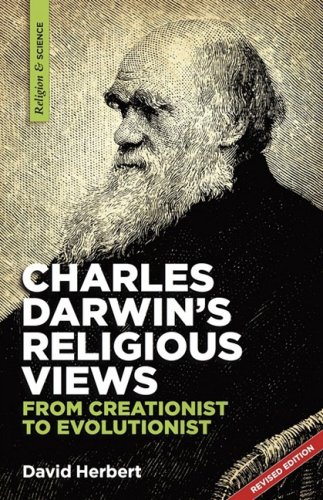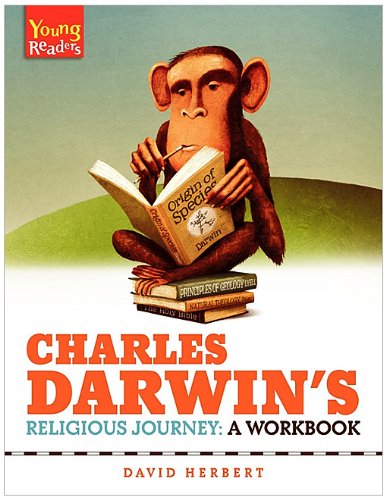Reviewed by Danny McDonald
Hebert opens his work by setting the religious context of Darwin’s family. Charles Darwin’s father came from a line of influential intellectuals and scientists. Robert Darwin (Charles’ father) was a medical doctor, and his grandfather (Erasmus Darwin) was a noted, scientifically adept physician. Known as England’s first evolutionist (5), Erasmus Darwin set forth such ideas in his controversial book Zoonomia; or, the Laws of Organic Life (6) and his posthumously published The Temple of Nature (7). Though Erasmus Darwin’s evolutionary views led him to reject Scripture as a “supernatural authority” (6), he still considered himself as a Deist, a worldview that Charles’ father espoused as well.
Charles Darwin’s maternal grandfather – Josiah Wedgewood – was an influential businessman and potter in England. Through his work, he came into contact with Joseph Priestley, who espoused “biblical Unitarianism” (9). Wedgewood appointed Priestley as teacher of a school he founded near his pottery factory, and through Priestley’s influence, the Wedgewood family became Unitarians (11).
The young Charles Darwin began his education in an Anglican school, but after one year was sent to the Wedgewood’s school to learn under Priestly. His exposure to Priestley’s Unitarianism led to a gumbo of religious influences in his life, ranging from his father’s deistic skepticism to the Unitarianism of his sisters and the Wedgewoods (15). Nevertheless, Charles Darwin believed at a young age in the existence of a Supreme Being.
Chapters 2 and 3 outline the various intellectual influences on Darwin during is his college years. He began college at the University of Edinburgh, where evolutionary theories abounded (17). He initially enrolled to study medicine, but he began to skip his medical classes to attend lectures on geology and zoology and eventually changed his major to the natural sciences.
Throughout his studies, Darwin came into contact with thinkers and professors who would play a significant role in his academic and intellectual life. While at Edinburgh, he joined the Plinean Society – a forum where members could freely discuss scientific matters – and there met one of his strong influences, Robert Edmund Grant, a respected zoologist and evolutionist. Darwin, however, would not complete his studies at Edinburgh, for in 1827, he transferred to Cambridge to begin studies for the Anglican ministry (23).
Even in the midst of his religious studies, Darwin still pursued his interest in natural science. He would traverse the countryside to collect beetle specimens for etymologists (25). As at Edinburgh, Darwin would skip his required lectures to attend, in this case, John Stevens Henslow’s botany classes. Henslow would soon introduce Darwin to Adam Sedgewick, a well-known geologist with whom Darwin would travel to study geology. Perhaps Henslow’s greatest influence was his referring Darwin to Captain Robert FitzRoy of the HMS Beagle. In 1831, Darwin joined FitzRoy on the Beagle as the ship’s resident naturalist. As FitzRoy navigated the world to help map the coasts of South America and the Pacific islands, Darwin was able to pursue his studies in geology and zoology.
Hebert gives the account of Darwin’s “conversion” to evolution and its resulting impact on particular relationships in Chapter 4 and 5. Upon returning to London, Darwin met with John Gould (an ornithologist and taxidermist), who had been studying the specimens Darwin sent to London from the Beagle. Per Gould, Darwin had found specifies from the Galapagos that were new and to be found nowhere else. According to Hebert, this meeting began Darwin’s new journey as an evolutionist. For the next two years, Darwin would record insights and observations from his research to begin building upon the evolutionary ideas that preceded his work. During this period, he read Thomas Malthus’ Essays on the Principles of Population, noting Malthus’ assertion that “there was an ongoing struggle between population growth and the availability of food” (57). Upon completing Malthus’ book, Darwin found a naturalistic mechanism that drove evolution – natural selection. For Darwin, evolution no longer needed an appeal to any supreme being – evolution could now be an entirely naturalistic explanation of the known world.
The captain of the HMS Beagle, however, would travel a different journey after returning to London. Just months after returning home, FitzRoy experienced a spiritual awakening and converted to Christianity (79-80). His new-found faith and his account of the voyage on the Beagle eventually caused a rift between the shipmates as FitzRoy espoused a belief in the Genesis creation account and express regret over Darwin’s evolutionary ideas.
Hebert devotes Chapter 6 to Darwin’s Origin – “the ‘sacred text’ of naturalism” (85). Prior to Origins, Robert Chambers had anonymously published Vestiges of the Natural History of Creation (1844), a book in which he wrote the first English full-length work on evolution (86). For Darwin, Chambers’ work affirmed much of his own research and conclusions, but Darwin disagreed with Chambers’ affirmation of a deistic God who set into motion the evolutionary process. For Darwin, though, the most significant weakness was the lack of a naturalistic mechanism for change (89). Darwin knew that his research would help overcome this persistent issue in previous evolutionary works, but he had to improve his credentials as a scientist before publishing his theory. And so he spent eight years studying barnacles. Because of his meticulous work, Darwin received the Royal Medal in 1853, giving him the scientific validation needed.
Darwin’s Origins was well-received by the scientific community, winning over converts from a deistic worldview to a full-blown evolutionary, naturalistic worldview. His work was either highly praised or vehemently rejected, yet, despite the mixed reviews, Darwin’s ideas were being discussed and spread about, making his a household name.
Chapters 7 and 8 address two matters Darwin settled after the publication of Origins – the existence of God and the problem of death. Despite Darwin’s conversion to evolution, he remained a member of the Anglican church in his community. Though he did not attend regularly (though his wife did), Darwin was faithfully involved in the church’s ministries, such as outreach to the poor (117-118). Nevertheless, Darwin struggled over the question of God.
After the publication of Origins, Darwin corresponded with Asa Gray, to whom he could bare his soul regarding questions of design and the question of God. In one letter, Darwin asserted that he would “not entertain atheism” (120). Initially, he landed on the solution of an impersonal, deistic being – a First Cause (120).
Darwin’s next major work, The Descent of Man, argued that man was not a special creature of its own kind, but rather that man and animal shared a common ancestry. Of his view on common ancestry, Darwin never wavered, but regarding God, Darwin was never settled – he could never come to a firm conclusion (130).
Hebert’s discussion on Darwin’s view of death provides a glimpse into Darwin the man. Over the course of his life, the deaths of family – the death of his mother, father, and young daughter Annie – and the deaths of close friends would shake Darwin to the core. In a letter to a friend, Darwin confessed that the question of suffering and death was his “pet horror” (136). Hebert connects Darwin’s question on death with his later studies on the earthworm – the lowly creature that lived buried in the earth. As he did with barnacles, Darwin meticulously studied the ways of the earthworm, publishing his work in his final book, The Formation of Vegetable Mould, through the Action of Worms, with Observations of Their Habits.
Hebert concludes his work by addressing Darwin’s supposed deathbed conversion. In 1915 at a Bible conference in America, an Englishwoman named Lady Hope told of her encounter with Darwin on his deathbed where he renounced his evolutionary worldview and turned to Christ. Lady Hope’s account was published in a Baptist paper, an account that is still referred to and repeated decades later. Despite the feel-good nature of Hope’s story, Hebert notes that evidence from Darwin’s own writings and those of those close to him paint a different picture. For Hebert, it is most likely that Darwin went to the grave an unchanged man.
Assessment
Hebert’s book is an accessible and thorough account of Darwin’s journey from a Unitarian creationist to an evolutionist. Though the book is useful for the believer of most any age, Charles Darwin’s Religious Views is probably best suited for middle and high school-aged students. The tone and style with which Hebert writes is that of one instructing another on who to apply the Christian worldview to the analysis of Darwin’s worldview. This claim is affirmed by the companion workbook Hebert published, titled Charles Darwin’s Religious Journey: A Workbook. It guides the young reader through their reading of Charles Darwin’s Religious Views, asking questions intended to strengthen students’ critical thinking skills and to think through the Christian worldview. Charles Darwin’s Religious Views would be a great book for young Christians who seek to think through their Christian worldview and to understand how to address evolution.

